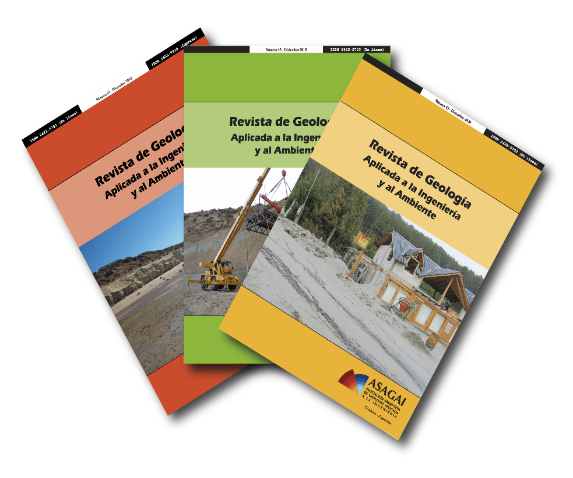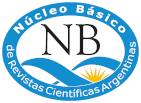Evaluation of geologic risk in the El Salado stream basin, within the framework of sustainable development of the Iglesia department, San Juan
DOI:
https://doi.org/10.59069/24225703ee018Keywords:
runoff, basin, ecosystem, vegetationAbstract
The sub-basin of the El Salado stream is part of the surface drainage network of the Blanco River, in the north of the province of San Juan. Its head is developed in the Colangüil mountain range, where sandstones from the Cerro Agua Negra formation, upper Paleozoic age, outcrop. These have been intruded by the granite rocks of the Los Puentes pluton, upper Permian– lower Triassic in age.
The water system is supported by snow and rainfall, less than 100 mm annually. Approximately half of the longitude of its main axis is extended on modern alluvial material. The area exceeds 400 km2, allowing an extraordinary water runoff greater than 150 m3/sec. The addition of solid material, before an immediate runoff, would be incorporated in the lower segment of the basin, where both terraces and river channel materials, and shrubby species predominate. Another important risk is seismic, as it presents high-intensity events in the historical distribution of earthquakes in northwest Argentina.
The vegetation cover, in a section of the alluvial valley, exhibits a characteristic distribution of patches, constituted predominantly by Larrea divaricata, Bulnesia retama, and another, of lesser coverage, of scrub of Proustia cuneifolia or mendocina. The wet surface of the channel for much of the year or, failing that, the shallow depth of the groundwater and the type of soil with high permeability characterize the balanced ecosystem for the latter species, and constitute a hydrogeological exploration guide.
References
Aguiar, Martín R. and Sala, Osvaldo E. (1999). Patch structure, dynamics and implications for the functioning of arid ecosystems. TREE vol. 14, no. 7 July 1999
Benavídez de Albar Díaz, M. (2016). Oro y plata en la historia minera de San Juan. Editorial UNSJ. ISBN 978-987-3984-22-8.
Bonvissuto, G.L. y Busso, C.A. (2006). Ascenso hidráulico en y entre isletas de vegetación en la zona árida de Argentina. ?YTON, Revista Internacional de Botánica experimental 75: 55-70.
Busquets, P., Méndez-Bedia, I., Gallastegui G., Colombo, F., Cardó, R., Limarino O., Heredia N. and Césari, S. N. (2013). The relationship between carbonate facies, volcanic rocks and plant remains in a late Paleozoic lacustrine system (San Ignacio Fm, Frontal Cordillera, San Juan province, Argentina). International Journal of Earth Sciences (Geol Rundsch) 102:1271–1287.
Cardó, R., I. Díaz, S. Poma, V. Litvak, G. Santamaría y Limarino, O. (2007). Hoja Geológica 2969-III Malimán, Provincia de San Juan, a escala 1: 250.000. Instituto de Geología y Recursos Minerales, SEGEMAR, Boletín 320, 52 pág., Buenos Aires.
Castro, C. E. (1987). El batolito de Colangüil entre las quebradas de la Pancha (30º latitud sur) y Agua Blanca (30º 16’ latitud sur). Geología y mineralización asociada. San Juan. Actas 10º Congreso Geológico Argentino, 4: 100 - 103. S. M. de Tucumán.
Destino San Juan (2020). https://mineriaydesarrollo.com/2020/08/03/fideicomisos-en-san-juan-que-se-hizo-y-se-hara-con-fondos-mineros/
Hoffman, J.A.J. (1975). Atlas climático de América del Sur, 1ra parte, Temperatura y Precipitación. UNESCO-OMN. Cartografía Budapest, Ginebra.
INPRES (2023). Registros históricos. http://contenidos.inpres.gob.ar/sismologia/linkppal
Instituto de Investigaciones Hidráulicas, UNSJ. (2001). Análisis de los impactos sociales, económicos, culturales y ambientales de la minería. Informe 3. Proyecto PASMA - Desarrollo Sustentable. Componente Ambiental San Juan. Inédito.
Instituto Nacional del Agua (2020). Mapas en línea de lluvias máximas diarias con recurrencia asociadas (PMD) y valor límite estimado para la República Argentina. Consultado el 7 de agosto de 2020.
Llambías, E.J. y Sato, A.M. (1990). El Batolito de Colangüil (29-31ºS), Cordillera Frontal de Argentina; estructura y marco tectónico. Revista Geológica de Chile, vol. 17, No. 1, 89-108. Servicio Nacional de Geología y Minería. Santiago, Chile.
Martínez Carretero, Eduardo (Ed.), (2007). Diversidad biológica y Cultural de los Altos Andes Centrales de Argentina. Línea de base de la reserva de biósfera San Guillermo - San Juan. Martínez Carretero, E. editor, 1a ed. San Juan; Univ. Nacional de San Juan. 284 p. 26x19 cm. ISBN 978-950-605-528-8
Mesa Permanente de la Gestión Integrada del Agua (2023). Gobierno de San Juan. https://hidraulica.sanjuan.gob.ar/normativas/lineamientos.php
Ministerio de Justicia y Derechos Humanos-Presidencia de la Nación (1999). Convenios
Muñoz M.R., Squeo, F.A., Leon M.F., Tracol, Y. and Gutierrez, J.R. (2008). Hydraulic lift in three shrub species from the Chilean coastal desert. Journal of Arid Environments 72 (2008) 624–632.
NRCS, “National Engineering Handbook Hydrology Chapters” (2015), (En línea). Recuperado el 8 de junio de 2022. Disponible en: http:// www.nrcs.usda.gov/wps/portal/nrcs/detailfull//
Perucca, P. L. y Bastías H. E. (2005). El Terremoto Argentino de 1894: Fenómenos de Licuefacción asociados a Sismos. En: Aceñolaza F. G. et al. (Eds.) INSUGEO, Serie Correlación Geológica, 19: 55-70. Tucumán. IBSN 1514-4186 - ISSN on-line 1666-9479
Polanski, J. (1958). El bloque varíscico de la Cordillera Frontal de Mendoza. Asociación Geológica Argentina, Revista 12 (3): 165-196. Buenos Aires.
Regairaz, M. C. (1996). Clasificación Taxonómica de Suelos; San Juan. Inventario de Recursos de La Región Andina Argentina. Junta de Andalucía, Gobiernos y Universidades de la Región Andina.
Reynolds, James F., Paul R. Kemp, Kiona Ogle and Roberto J. Fernández (2004). Modifying the ‘pulse–reserve’ paradigm for deserts of North America: precipitation pulses, soil water, and plant responses. Oecologia (2004) 141: 194–210 - DOI 10.1007/s00442-004-1524-4
Servicio Informático Gobierno de San Juan. https://sisanjuan.gob.ar/interes-general/2019-10-15/18050-san-juan-y-su-variada-flora-autoctona
Servicio Informático Gobierno de San Juan. Obtenido el 5/10/2020. https://sisanjuan.gob.ar/planificacion-e-infraestructura.
Servicio Informático Gobierno de San Juan, Turismo y Cultura, (2021). https://sisanjuan.gob.ar/turismo-y-cultura/2021-05-14/31968
Tiempo de San Juan (2014). tiempodesanjuan.com/terremoto-1894-68612.html www.todo-argentina.net
United States Geological Survey. Earth Explorer. Obtención de Imágenes Satelitales de descarga gratuita https://earthexplorer.usgs.gov/
Van Wambeke, AR and CO Scoppa. (1976). Las taxas climáticas de los suelos argentinos (Determinación de las definiciones del Soil
Taxonomy, utilizando el modelo matemático de Newhall y computación Fortran). Revista de Investigaciones Agropecuaria (RIA-INTA). Serie 3: Clima y Suelos XIII 1: 7-39.
Ven te Chow, Maidment, David R. and Mays, Larry W. (1994). Hidrología Aplicada. Ed McGraw Hill (1Ed).
Wetten, Aníbal. F., Vargas Luna, Germán y Wetten, Paula A. (2022). Características hídricas de una cuenca de alta montaña y aptitudes de la vegetación como mecanismo de ascenso hidráulico. Departamento Iglesia, provincia de San Juan. XI Congreso Argentino de Hidrogeología. Bahía Blanca, Argentina.
Downloads
Published
Issue
Section
License
Copyright (c) 2024 Aníbal Wetten

This work is licensed under a Creative Commons Attribution-NonCommercial-ShareAlike 4.0 International License.
Attribution - Non-Commercial - Share Alike (by-nc-sa): No commercial use of the original work or any derivative works is permitted, distribution of which must be under a license equal to that governing the original work.










